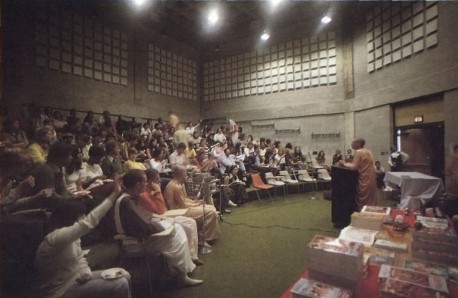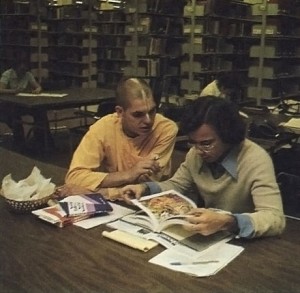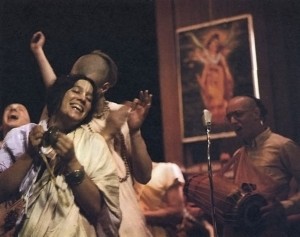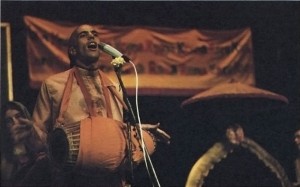by Revatinandana Svami
THE EXPRESSION “Krishna consciousness” indicates a life of progressing spiritual awareness that prepares one to enter the eternal association of Krishna (God) even before the death of the body. Devotional service to Krishna (bhakti-yoga) is a practical life of rendering service to God under the guidance of the Vedic scriptures and a personal spiritual master. When the spiritual master is bona fide, the results of such spiritual service are complete detachment from the alternating pains and pleasures of materialistic life, and an increasing experience of spontaneous joy from within, indicating the awakening of the spirit soul’s love of God.
According to scriptures, one who experiences the extraordinary, ever-increasing happiness of Krishna consciousness should feel obligated to extend the benediction his spiritual master has bestowed on him by attractively presenting the devotional process to others. In Bhagavad-gita Lord Krishna says that, among His servants, one who extends himself by presenting Krishna consciousness to others who are receptive becomes the most dear servant of all. By becoming very dear to Krishna one makes the most rapid advancement in devotional service, and therefore intelligent devotees try to preach Krishna consciousness.
The main benefit of associating with a true spiritual master comes by understanding and implementing his divine instructions. A spiritual master will produce volumes of books describing and applying the Vedic principles according to the particular time and circumstances in which he is preaching. A disciple who wishes to begin preaching, therefore, finds his best beginning in attempting to convince others that they should read his spiritual master’s literature. As he becomes expert in this, and also becomes very learned in the Vedic teachings, he may find that the spiritual master is commissioning him increasingly to go out, attract audiences, and attempt to convince them himself. Doing this, he automatically will attract serious interest in his guru’s books, and he may rise to the high standard of spiritual realization where he himself can begin to produce pure, potent literature.
Often devotees find that because of their bodily and emotional nature, they feel happier when married and raising a family in Krishna consciousness. Supporting a family generally means that a devotee will not be able to devote much of his time to active preaching, so he is recommended to preach whenever he finds an opportunity, and at the same time try to set aside fifty percent of his acquired wealth to give to those engaged fully in preaching work.
Occasionally, however, we find a devotee who becomes so absorbed in devotional practices and preaching that he becomes steadily free of disturbance from sexual desire. The enjoyment of devotion to Krishna frees him from all other desires, and therefore he may decide to forego marriage and family life to fully concentrate on reaching the larger family of humanity with the message of Krishna consciousness. Such a factually renounced preacher may eventually formalize his position by accepting initiation by his spiritual master into sannyasa, the renounced order of life. At that time he accepts the title “svami” (controller of the senses), along with the responsibilities of maintaining strict celibacy, keeping to the minimum his material eating and sleeping and accumulation of material possessions, and preaching Krishna consciousness everywhere. Such a qualified sannyasi is revered as a spiritual leader by all other classes of men in the Vedic culture.
After spending two years learning the principles of Krishna conscious life in America, where I joined the movement in 1968, I traveled to India with my guru in 1971 to assist him in establishing some centers there (an attempt to reinterest the people of India in the ancient scriptural culture they have come to neglect in recent centuries). In 1972, in Calcutta, I entered the renounced order, and at the end of 1972 my spiritual master commissioned me to travel to the United Kingdom to instruct his newer British disciples in the principles of devotional service and preach widely among the people of Great Britain.

In Britain, like everywhere in the West, the most immediate and serious interest in the Krishna consciousness movement is found in the younger generation-particularly among some sections of the student and “hip” communities. There are several reasons for this, one being that young people are generally less set in their ways and therefore more liberal in examining new horizons. Another reason is that many of the more intelligent youth of today have examined the materialistic life of their parents and found it wanting even at its best. They are therefore more receptive to the idea of using their lives for spiritual realization than their predominantly materialistic forefathers.
My spiritual master, His Divine Grace A.C. Bhaktivedanta Swami Prabhupada, once said that the student community would provide the best source of prospective candidates for Krishna consciousness. Bhagavad-gita also confirms that when a very intelligent person understands Lord Krishna to be the Supreme Truth and surrenders to His devotional service, that wise person becomes the dearest of all who approach the Lord. Because of their youth, intelligence and developing qualifications, students at colleges and universities certainly have the greatest potential to lead in eventually spreading Krishna consciousness to every town and village around the world. Also, because of their congregating for eight months of the year on and near college campuses, it is possible to attempt a systematic program to canvas them for interested souls. Therefore, I decided to concentrate primarily on presenting our process to the student community.
With this idea in mind, in the summer of 1972 I approached the householder devotees who manage our Society’s incense and cosmetics business (Spiritual Sky Scented Products) to inquire whether they would like to purchase a suitable estate car (station wagon) for my use. Seeing it as an opportunity to use their acquired wealth to advance our spiritual master’s movement, they agreed.
The next step was to choose, with the presidents of our British temples, four steady and intelligent brahmacaris (unmarried student disciples) to fill out a traveling party. The requirements were that they be interested, personable and sufficiently learned in the philosophy of Krishna consciousness to speak convincingly with intelligent young people. When this group was formed, we began to amass the necessary paraphernalia to travel for weeks away from our centers and actually perform engagements. This included musical instruments to accompany Hare Krishna chanting, cooking utensils and storable Vedic foods, a large banner with the Hare Krishna mantra, some holy pictures for a portable altar, a supply of our spiritual master’s books, and our basic personal effects and bedding. We carefully arranged all these to fit (tightly) into the car, and physically we were prepared to move.

One of the boys, who was extremely steady and fixed in his determination to serve Krishna, set out ahead of time. Sometimes using trains and buses but usually simply hitchhiking, he began making his way along a prearranged route. Beginning from Scotland and traveling south through Wales and England, he began systematically approaching the student-union executives at nearly all colleges and universities to inquire whether they wished to invite us for programs about the Hare Krishna movement. Finding that about seventy percent of the student leaders responded with interest, he would proceed to arrange the dates, publicity and other details of the programs. He would also arrange donations averaging £ 10 ($25) to maintain our party, and usually a place on the campus for us to spend the night.
Traveling ahead like this, he was able to fill nearly every day of the school year with one, if not two (morning and evening), programs. We traveled along behind actually doing the programs, maintaining the party by the prearranged donations and finding that Krishna always provided us with a place to rest.
When the colleges were on their end-of-term breaks, we arranged our own programs at cities throughout Britain.
Renting a hall for an evening, making publicity and selling inexpensive tickets to finance the affairs, we did successful programs attended by fifty to two hundred at Glasgow, Liverpool, Sheffield, Nottingham, Oxford, Cambridge, London and Plymouth. We also did numerous programs at youth clubs and secondary schools (high schools) in these “open” periods.
On the day of a typical program, after our early morning devotional practices, we would prepare one or two simple but delicious vegetarian dishes (wherever Krishna provided a kitchen) and offer them to the Lord with devotion. The resulting prasada (spiritual food) was partially for our own consumption but mainly for distribution at the program, and whenever there was time the brahmacaris would go to a nearby town to distribute literature and chant Hare Krishna, while I retired to a public library to study and write.
As the time for the program arrived, we would go to the campus hall where it was to take place, assemble a simple altar and book array and prominently display the Hare Krishna mantra banner. The altar centered around a large oil painting of Lord Caitanya dancing with His associates. Lord Caitanya appeared in Bengal about five hundred years ago, and scriptures compiled long before predicted His appearance as an incarnation of Krishna Himself. He inaugurated the movement of sankirtana (chanting the names and glories of God), of which we are a part. My spiritual master had instructed me to take such a picture along because the Lord is described to be personally present in such transcendental pictures and because His golden form as a devotee (Lord Caitanya) is the most immediately attractive and understandable of all His incarnations.
As the students (usually from 50 to 250 if the program was properly publicized) came in and took seats, I would briefly introduce our movement as a movement for spiritual awakening and realization based on the ancient Vedic scriptures and handed down by a long line of spiritual masters. I would explain that these scriptures recommend the chanting of the names of God as the most effective means of awakening Krishna consciousness in these days, and that we would begin the program by chanting for some time. First we would sing a prayer offering our respects to our guru and then chant the Hare Krishna mantra, in this way purifying the atmosphere to set the stage for speaking on spiritual matters. We invited them to join in the chanting if they liked.
The Vedic scriptures explain that the hearing and chanting of the names of God is essential for cleansing the heart and sanctifying the intelligence so that people may grasp the scriptural instructions for attaining perfection in life. They describe that as He is nondifferent from His picture, the absolute Lord is also nondifferent from His innumerable holy names (revealed in scriptures around the world), and that to be in the presence of the holy name is therefore to be in the presence of the Lord. Because the ear is the most acute of our senses, this hearing and chanting is the most effective means of awakening Krishna consciousness.

Generally, British students are relatively quiet and polite by nature and upbringing, but sometimes some sections of the audience would be loudly critical, heckling or simply being noisy at the beginning–especially after seeing us in our traditional robes and shaven heads. We found again and again, however, that although most students would not initially take part in the chanting, the effect of their simply hearing us chant with our instruments (small, metal cymbals and clay mrdanga drum) was to still and purify completely the atmosphere in the room. Taking advantage of that more receptive atmosphere, I was then able to address them for as long as an hour, appealing to their good intelligence by explaining the philosophy and practice of Krishna consciousness.
It is impossible to present a typical lecture here, but an outline of the basic points I would usually present is as follows:
(1) It is not possible to gain perfect spiritual knowledge by experimental science or speculative philosophizing, even about scriptures. Spiritual knowledge is acquired by hearing the scriptural message from a spiritual master coming in a line of disciples originating from a bona fide incarnation of Krishna, the origin of all knowledge.
(2) We do not accept the theory that life comes by chance from unliving matter. Our philosophy is that life appears in matter only when a living spirit soul is present. (Sometimes many arguments arose concerning this.)
(3) The spirit soul is eternal and unchanging. Therefore we are completely different from our bodies, which are born and will die. We have a spiritual way of enjoying eternally that is far superior to the material way of sometimes enjoying, sometimes suffering, accepting the miseries of old age, disease and death.
(4) The soul who quits his body in the attempt to enjoy the material world takes body after body there, enjoying and suffering the reactions to his past deeds.
(5) The Vedic scriptures describe God as the Supreme Person, with an eternal body full of unlimited knowledge, beauty, power and bliss. We can see the supreme, personal touch of Krishna even in His material creation, which is full of wonderful manifestations (flowers, human bodies, sunsets, etc.) that none of us have sufficient intelligence, beauty or power even to imitate.
(6) Everyone seeks loving relationships, but in the material world what we call love is always contaminated by selfish interests (lust). Such limited and’ temporary relationships do not fulfill our lives.
(7) The perfect friend and lover for every living being is the Personality of Godhead, Sri Krishna. Spiritual life is not to annihilate the individual self, as some profess, but to relate him with Krishna in an eternal loving relationship.
(8) Love of Krishna is awakened by devotional service to Him (bhakti-yoga). It begins with chanting the names of the Lord, hearing about Him from Vedic literatures, and tasting prasada. This awakening shows itself in the disposition to engage one’s life in His service. The final result is that one will leave his body in a divine state of love of God and enter the eternal realm of the Lord as His personal associate.
(9) Service to Krishna is practical. It does not necessarily require one to give up his family or career. While some may do this, as traveling preachers, one may also practice bhakti-yoga by raising a family in Krishna consciousness and learning from the spiritual master how to use one’s work, wealth, talents and abilities in advancing the Krishna consciousness movement-while engaging in the basic devotional practices. (chanting, etc.)
(10) If one begins to practice this, he can appreciate for himself the wonderful transformation that comes over his life. Because this process is practical for all and links us with the all-auspicious Lord, we are distributing it around the world as a practical solution for the problems of mankind, material as well as spiritual.
(11) Whoever wishes to understand and experience Krishna consciousness more fully can do so simply by chanting Hare Krishna regularly, tasting prasada (such as that to be distributed at the end of the program), reading the books on these teachings, and sometimes visiting centers of the International Society for Krishna Consciousness to observe the actual functioning of the society of devotees.
(12) No one should pass without a serious investigation of such a process, which offers a satisfying life of spiritual awakening and can lead one past the death of his material body into a life of eternity, bliss and knowledge-a life experienced by pure devotees of the Lord even before the death of their bodies.
In most circumstances I would open the program for questions at this point. Because the lecture was delivered more as a presentation than as a direct proselytizing attempt, it usually found a quite receptive audience, and therefore the questions were normally expository rather than challenging. After taking several such questions, and especially if an argument were developing (meaning intelligence giving way to anger), I would invite everyone to take part in an ending chant to actually experience the blissful potency of the revealed names of God.
Whereas in the beginning most students would simply watch us chant, after a reasonable talk they were often inclined to join in. Usually from fifty to one hundred percent of them would stand, clap and join in the chanting, regardless of the conservatism or liberality of that particular student body. By the end of the chant they would often become thoroughly aroused and afterwards express their enjoyment by appreciative words and exclamations.
After this conclusion I would invite them to taste some fruit and a sweet grain preparation (halavah) we had earlier offered to Krishna, to speak further with the devotees if they had more questions, and especially to look at the books of our spiritual master and our other literatures. The ensuing discussions with ten to thirty of the more interested students would often go on for one, two or even three hours. They usually ate all the prasada with relish, and interested readers purchased a number of our major books, many magazines, and essays I had written and printed for students. As devotees preaching for Krishna and our spiritual master in this way, we used to conclude almost every program feeling happy to the point of ecstasy.
My spiritual master told me that if the students asked good questions and were motivated to take literature, that indicated that the program had been potently effective. Since this was nearly always the case, we are confident that in the course of doing 150 such programs all over Britain, we have made some beginning—a planting of seeds that may gradually grow into a Krishna conscious generation of people who will alter, for the good, both the United Kingdom and the world. Many British young people show a healthy attraction for the chanting of the Hare Krishna mantra, and this process alone, according to the Vedic scriptures, will illuminate this materialistic age.
In the coming school year we plan to make a second tour through all the colleges and universities here, meeting new students and also observing how some who attended last year’s programs have developed by this simple, pure association. Already many have come, on their summer travels, to visit our temples, and a few have actually joined our society as full-time students of our spiritual master. In this way we are encouraged to push on, in secondary and primary schools as well, and wherever an audience presents itself. We eagerly await the golden days of the Krishna conscious world-culture the Vedic literatures predict for this age as the result of the appearance of Lord Caitanya and His glorious sankirtana movement of chanting the holy names of God.


Leave a Reply